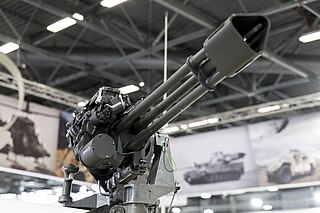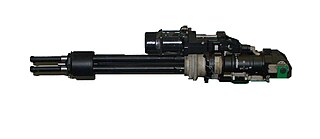Related Research Articles

The Bell OH-58 Kiowa is a family of single-engine single-rotor military helicopters used for observation, utility, and direct fire support. It was produced by the American manufacturer Bell Helicopter and is closely related to the Model 206A JetRanger civilian helicopter.

The M61 Vulcan is a hydraulically, electrically, or pneumatically driven, six-barrel, air-cooled, electrically fired Gatling-style rotary cannon which fires 20 mm × 102 mm rounds at an extremely high rate. The M61 and its derivatives have been the principal cannon armament of United States military fixed-wing aircraft for over sixty years.

A gunship is a military aircraft armed with heavy aircraft guns, primarily intended for attacking ground targets either as airstrike or as close air support.

The Douglas AC-47 Spooky was the first in a series of fixed-wing gunships developed by the United States Air Force during the Vietnam War. It was designed to provide more firepower than light and medium ground-attack aircraft in certain situations when ground forces called for close air support.

A chain gun is a type of autocannon or machine gun that uses an external source of power to cycle the weapon's action via a continuous loop of chain similar to that used on a motorcycle or bicycle, instead of diverting excess energy from the cartridges' propellant as in a typical automatic firearm.

The M230 Cannon is a 30 mm (30×113 mm), single-barrel electrically-driven autocannon, using external electrical power to cycle the weapon between shots. It was designed and manufactured originally by Hughes Helicopters in Culver City, California. As of 2019, it is produced by Northrop Grumman Innovation Systems.
The M134 Minigun is an American 7.62×51mm NATO six-barrel rotary machine gun with a high rate of fire. It features a Gatling-style rotating barrel assembly with an external power source, normally an electric motor. The "Mini" in the name is in comparison to larger-caliber designs that use a rotary barrel design, such as General Electric's earlier 20 mm M61 Vulcan, and "gun" for the use of rifle ammunition as opposed to autocannon shells.
The Gryazev-Shipunov GSh-23 is a twin-barreled 23 mm autocannon developed in the Soviet Union, primarily for military aircraft use. It entered service in 1965, replacing the earlier Nudelman-Rikhter NR-23 and Rikhter R-23.
Rate of fire is the frequency at which a specific weapon can fire or launch its projectiles. This can be influenced by several factors, including operator training level, mechanical limitations, ammunition availability, and weapon condition. In modern weaponry, it is usually measured in rounds per minute or rounds per second.

A rotary cannon, rotary autocannon, rotary gun or Gatling cannon, is any large-caliber multiple-barreled automatic firearm that uses a Gatling-type rotating barrel assembly to deliver a sustained saturational direct fire at much greater rates of fire than single-barreled autocannons of the same caliber. The loading, firing and ejection functions are performed simultaneously in different barrels as the whole assembly rotates, and the rotation also permits the barrels some time to cool. The rotating barrels on nearly all modern Gatling-type guns are powered by an external force such as an electric motor, although internally powered gas-operated versions have also been developed.

The Boeing MH-6M Little Bird and its attack variant, the AH-6, are light helicopters used for special operations in the United States Army. Originally based on a modified OH-6A, it was later based on the MD 500E, with a single five-bladed main rotor. The newest version, the MH-6M, is based on the MD 530F and has a single, six-bladed main rotor and four-bladed tail rotor.

The XM214 Microgun is an American prototype 5.56 mm rotary-barreled machine gun. It was designed and built by General Electric. The XM214 was a scaled-down smaller and lighter version of the M134 Minigun, firing M193 5.56×45mm ammunition.

The United States military has developed a number of Helicopter Armament Subsystems since the early 1960s. These systems are used for offensive and defensive purposes and make use of a wide variety of weapon types including, but not limited to machine guns, grenade launchers, autocannon, and rockets. Various systems are still in use, though many have become obsolete.

The GAU-19/A is an electrically driven, three-barrel rotary heavy machine gun that fires the .50 BMG (12.7×99mm) cartridge.

The McDonnell Douglas Helicopter Systems MD 500 Defender is a light multi-role military helicopter based on the MD 500 light utility helicopter and OH-6 Cayuse Light Observation Helicopter.

The Glagolev-Shipunov-GryazevGShG-7.62 is a four-barreled rotary machine gun designed in the Soviet Union, similar to firearms such as the M134 Minigun. It is a hybrid weapon using both propellant gas and an electric drive to rotate the barrels, which is in contrast with most other rotary guns. It was developed in 1968–1970 for the Mi-24 helicopter together with YakB 12.7mm machine gun, and is currently used in GUV-8700 gun pods, and flexible mounts on Kamov Ka-29.

A multiple-barrel firearm is any type of firearm with more than one gun barrel, usually to increase the rate of fire or hit probability and to reduce barrel erosion or overheating.
The Hua Qing minigun is a Chinese Gatling-type machine gun. The weapon is chambered in the 7.62×54mmR round, and was introduced at the 2009 Anti Terrorist Trade Show at Beijing.
The XM133 Minigun is a 6-barreled Gatling-type machine-gun. The weapon is a self-powered, gas-operated variant of the M134 Minigun. It fired over 3000 rpm but was not put into production.
The AAI In-Line was a prototype aircraft machine gun developed by AAI Corporation. The weapon was intended for potential aircraft use and capable of high rate of fire similar to the M134 Minigun but with the accuracy of a fixed barrel machine gun. The In-Line machine gun concept worked and passed air force tests but was not further developed. Around three of them were manufactured. The only known example is on display at the Air Force Armament Museum.
References
- 1 2 "USA - EX-17 Heligun : Zbraně s revolverovým závěrem (Systém Clarke)".
- ↑ "EX-17 Heligun". 31 October 2011.
- ↑ "Multiple barrel machine gun" (PDF).